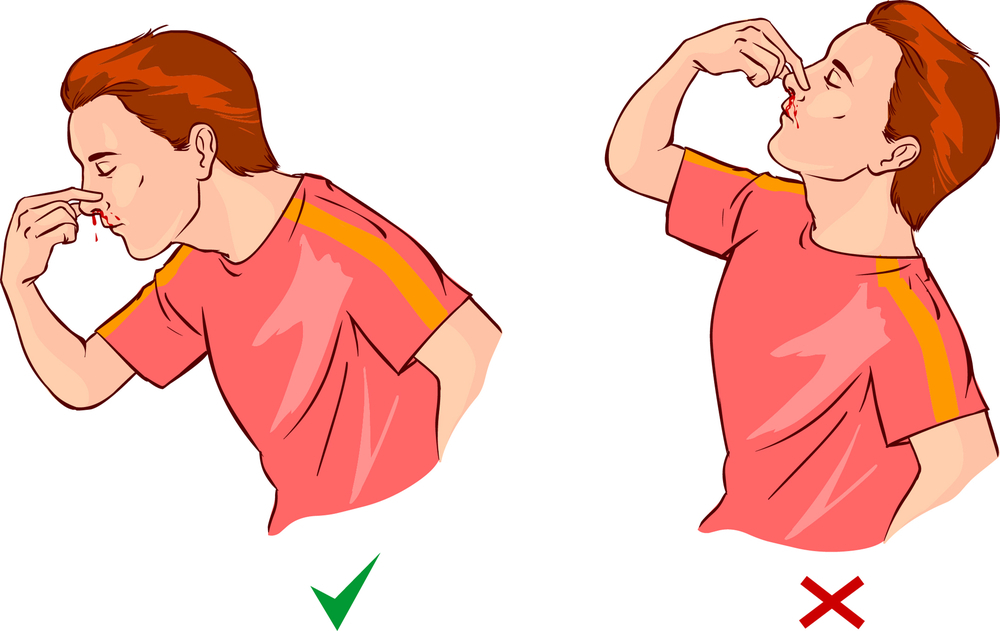Nosebleed (epistaxis)
Published (updated: ).

A nosebleed is loss of blood from the tissue lining the nose. Bleeding most often occurs in one nostril only.
Considerations
Nosebleeds are very common. Most nosebleeds occur because of minor irritations or colds.
The nose contains many small blood vessels that bleed easily. Air moving through the nose can dry and irritate the membranes lining the inside of the nose. Crusts can form that bleed when irritated. Nosebleeds occur more often in the winter, when cold viruses are common and indoor air tends to be drier.
Most nosebleeds occur on the front of the nasal septum. This is the piece of the tissue that separates the two sides of the nose. This type of nosebleed can be easy for a trained professional to stop. Less commonly, nosebleeds may occur higher on the septum or deeper in the nose such as in the sinuses or the base of the skull. Such nosebleeds may be harder to control. However, nosebleeds are rarely life threatening.
Causes
Nosebleed can be caused by:
- Irritation due to allergies, colds, sneezing or sinus problems
- Very cold or dry air
- Blowing the nose very hard, or picking the nose
- Injury to nose, including a broken nose, or an object stuck in the nose
- Sinus or pituitary surgery
- Deviated septum
- Chemical irritants including medicines or drugs that are sprayed or snorted
- Overuse of decongestant nasal sprays
- Oxygen treatment through nasal cannulas
Repeated nosebleeds may be a symptom of another disease such as high blood pressure, a bleeding disorder, or a tumor of the nose or sinuses. Blood thinners, such as warfarin (Coumadin), clopidogrel (Plavix), or aspirin, may cause or worsen nosebleeds.
Step one: stop the bleeding
To stop a nosebleed:
- Sit down and gently squeeze the soft portion of the nose between the thumb and finger (so that the nostrils are closed) for a full 10 minutes.
- Lean forward to avoid swallowing the blood and breathe through the mouth.
- Wait at least 10 minutes before checking if the bleeding has stopped. Be sure to allow enough time for the bleeding to stop.
It may help to apply cold compresses or ice across the bridge of the nose. Do not pack the inside of the nose with gauze.
Lying down with a nosebleed is not recommended. The patient should avoid sniffing or blowing your nose for several hours after a nosebleed. If bleeding persists, a nasal spray decongestant (Afrin, Neo-Synephrine) can sometimes be used to close off small vessels and control bleeding.

When the nosebleed is a problem
- Bleeding does not stop after 20 minutes.
- Nose bleeding occurs after a head injury. This may suggest a skull fracture, and x-rays should be taken.
- The nose may be broken (for example, it looks crooked after a hit to the nose or other injury).
- The patient is taking medicines to prevent blood from clotting (blood thinners).
- The patient has a history of nosebleeds in the past that needed specialist care to treat.
When the nosebleed is actually a symptom of a much worse problem
High blood pressure, medically known as hypertension, is a blood pressure reading higher than 130/80 millimeters of mercury (mm Hg). Stage 2 hypertension is defined as a blood pressure greater than 140/90 mm Hg.
It’s estimated that 108 million adults in the United States have high blood pressure, and only about a quarter of these people have their blood pressure under control. Having high blood pressure puts you at a heightened risk of developing potentially life-threatening conditions like a heart attack or stroke. High blood pressure is sometimes called the silent killer because it often doesn’t cause any noticeable symptoms.
Nosebleeds generally are not a symptom of high blood pressure. However, there’s still debate whether people with high blood pressure get more frequent or severe nosebleeds. Whether high blood pressure causes an increased risk of nosebleeds remains a topic of debate. Although high blood pressure isn’t known to directly cause nosebleeds, it’s probable that it may cause the blood vessels in your nose to be more susceptible to damage and increase bleeding time.
In a recent 2020 study, researchers used data from the Korean National Health Insurance Service to examine the risk of nosebleeds in people with high blood pressure. In a group of 35,749 participants, researchers found people with a history of hypertension had an increased risk of nosebleeds requiring hospital visits compared to people with no history of high blood pressure. According to the American Heart Association, high blood pressure doesn’t cause nosebleed unless you have extremely high blood pressure called a hypertensive crisis.
A hypertensive crisis is a sudden spike in your blood pressure over 180/120 mm Hg that can be life-threatening. It’s a medical emergency that requires immediate medical attention. When your blood pressure reaches this level, you’re at a high risk of blood vessel damage that can lead to serious conditions like:
- heart attack
- stroke
- kidney damage
- eclampsia
- eye damage
- pulmonary edema
People experiencing hypertensive crisis often experience nosebleeds from damage to the blood vessels in their nose. Other common symptoms include:
- headaches
- severe anxiety
- dizziness
- shortness of breath
- chest pain
- confusion
- nausea
- vomiting
